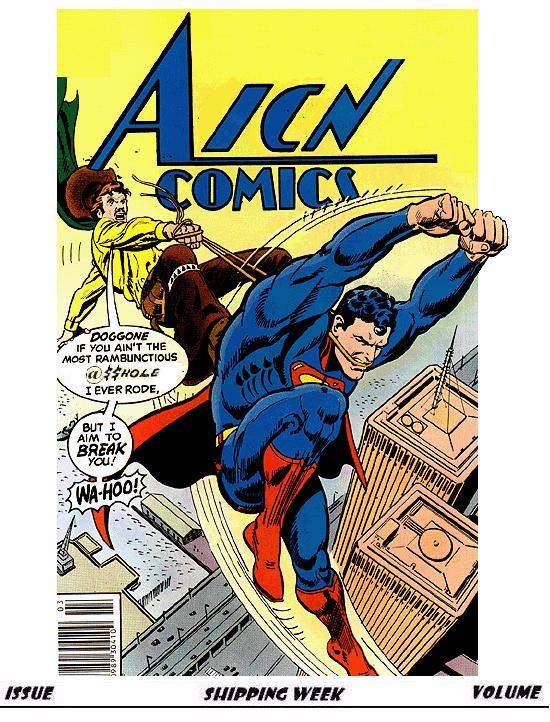
| #13 | 8/5/09 | #8 |
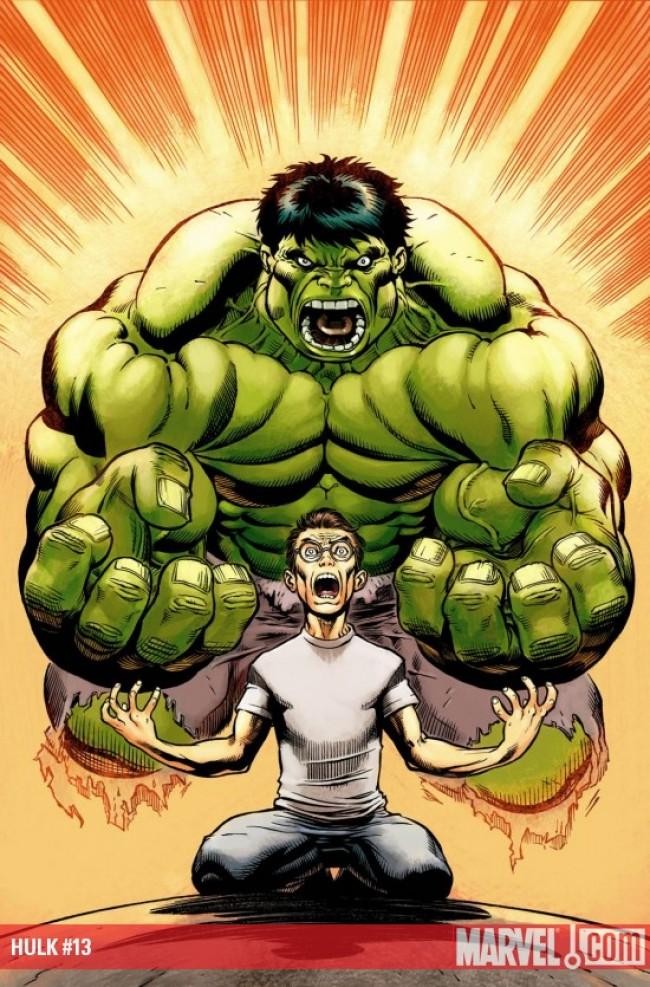
HULK #13
Writer: Jeph Loeb Art: Ed McGuinness Publisher: Marvel Comics Reviewer: Ambush Bug
I know this book takes a lot of flack and that fans have been quite vocal about Loeb’s recent writing assignments at Marvel. I don’t read ULTIMATES, but I hear he missed the boat big time with that title and because of this, the name Loeb is uttered with the same amount of contempt as Zimmerman and Austen used to back when I first started writing these comic booky reviews. “Loeb suxor!” is about all you usually get from the flock with little or no elaboration asked for or given. Well, Loeb’s HULK may not be the best version of the character, but it ain’t the worst either and I wanted to take the time to gab about it a bit in this review.There’s a whole new generation of readers who don’t remember when Hulk was really, really bad. I’m talking the Bruce Jones era when the Hulk never showed up in his main comic, Betty was turned into a super spy—then killed, and Doc Sampson banged her (before she died of course, you perv) and became the hero of the book for about 3 or 4 arcs. Someone at Marvel had the bright idea that showing super powers had become passé and suggested that the very thing that drew readers in (cool powers, that is) was to be kept to a minimum. That’s why we had a HAWKEYE series that quickly became a miniseries for many reasons, but mostly due to the fact that a bow and arrow wasn’t present at all in the series. Same goes for Hulk. Bruce Jones would have a giant page reveal at about issue three of his arcs where we’re supposed to reel back in our chair that the Hulk shows up. Instead, I found myself reeling back in my chair screaming “finally!” So when people complain that Loeb’s HULK is bad, I try to point out that awful era for the character.
Now, for the last year, Loeb’s been working on building up a little mystery asking “Who is Red Hulk?”, a crimson version of the gamma powered brute that showed up hot on the heels of the WORLD WAR HULK mega-event. Though they provided clues, they still haven’t revealed who Rulk is and I doubt they will since it’s the only thing that really is keeping a lot of folks interested in the title. Looks like another mystery in the form of Red She-Hulk will be popping up in the next month or two, so I guess we’ve got that to look forward to.
Now, while “Who is Rulk?” is not the most sophisticated of storylines, it does have a sort of reptilian brain simplistic appeal to it. Loeb dishes it out to us, red herrings and all (the prime suspect, Thunderbolt Ross, was ruled out when he came across an unconscious Rulk a while back), in a pretty straight-forward manner. No it’s not the sophisticated psychological drama that became associated with the book when Peter David ruled the roost and it’s the antithesis of Grant Morrison’s narrative pretzels, but I have to appreciate the book for not trying to be more than it is—big muscle-bound brutes fighting other big muscle-bound brutes. It ain’t Shakespeare but there’s a Rock ‘Em Sock ‘Em appeal to this book that takes me back to a time when the coolest thing you could do was bash your giant toys together and make fightin’ sounds in the sandbox in the backyard. That was entertaining once for all of us; it’s just that somewhere along the line, in an attempt to legitimize our own fascination with books originally designed for kiddies, we somehow convinced ourselves that having fun in comics is not allowed.
HULK #13 is far from a perfect issue. Loeb acts as if he’s making this shit up as he goes along. For some reason, when we last saw Hulk and Rulk, they were pounding the snot out of one another. The end of that match-up resulted in a victorious Rulk and a depowered Bruce Banner, forever more (yeah right) free of the Hulk. Though how Rulk depowered Hulk is another one of those mysteries (kind of like why the Hulk switches from grey and crafty Mr. Fixit, to brainless “Hulk Smash!” Hulk, to intelligent Professor Hulk from the Pantheon days, with no rhyme or reason), but as soon as I start trying to wrap my mind around stuff like that, I remind myself that I’m thinking too much for this comic. Loeb obviously is not trying to make all ends meet here whether by choice or by sheer “I give a shit not”-icity. Either way, if you overthink it, you’ll give yourself a conniption fit and none of us want that.
Issue #13 is filled with more random whack-a-mole style plotting. All of a sudden Norman Osborne is interested and sends Ares in to investigate which basically translates into having another excuse for a slugfest. Rick Jones in his A-Bomb form shows up (awful name, but Jones has had so many incarnations, he takes this one in stride—a reaction that I can believe coming from this character). In this issue, he somehow has Rick’s personality now (though in past appearances, he was a mindless monster) and new powers to blend into the walls like a chameleon (why?...what’d I tell you about asking questions?). But all of this is just an excuse to have A-Bomb, depowered Bruce, and Ares throw blows. And blows are thrown. And many a slug is fested. And if I were a young kid, I’d have loved the shit out of it. Fortunately, I try to push down that cynical adult, and as long as I kept telling myself not to worry my pretty little head about the hows and the whys, I found myself enjoying this book.
And that will be the deciding factor here for you with this book. Do you find yourself seeking out plot holes and cynically going, “Oh that’d never happen!” in movies and books? Do you look for heady themes and prefer the highbrow approach to all things? Do you long for a world where everything makes sense? If you answer “Hellz yes!” to these questions, then steer clear of Loeb’s HULK, my friend. This comic ain’t for you. But it’s a big comic book world out there. There’s even another Hulk book coming out soon written by Greg Pak so it’s bound to be less breezy and more attuned to the Hulk many of us know and grew up loving. There’s room for this Paris Hilton of a book too, though. A book dedicated to one guy punching another isn’t such a horrible thing. It doesn’t make a whole lot of sense, but if you’re ever in the mood to turn off that cynical, over-analyzing portion of your brain, HULK is the book you should turn to.
Ambush Bug is Mark L. Miller, reviewer and co-editor of AICN Comics for over eight years. Check out his short comic book fiction from Cream City Comics’ MUSCLES & FIGHTS VOL.3 and MUSCLES & FRIGHTS VOL.1 on his ComicSpace page. Bug was interviewed here and here at Cream City Comics. Look for more comics from Bug in 2009 from Bluewater Comics, including the sequel to THE TINGLER for their VINCENT PRICE PRESENTS ongoing series in stores September 2009 and VINCENT PRICE PRESENTS WITCHFINDER GENERAL and ROGER CORMAN PRESENTS DEATHSPORT to be released in late 2009/early 2010.
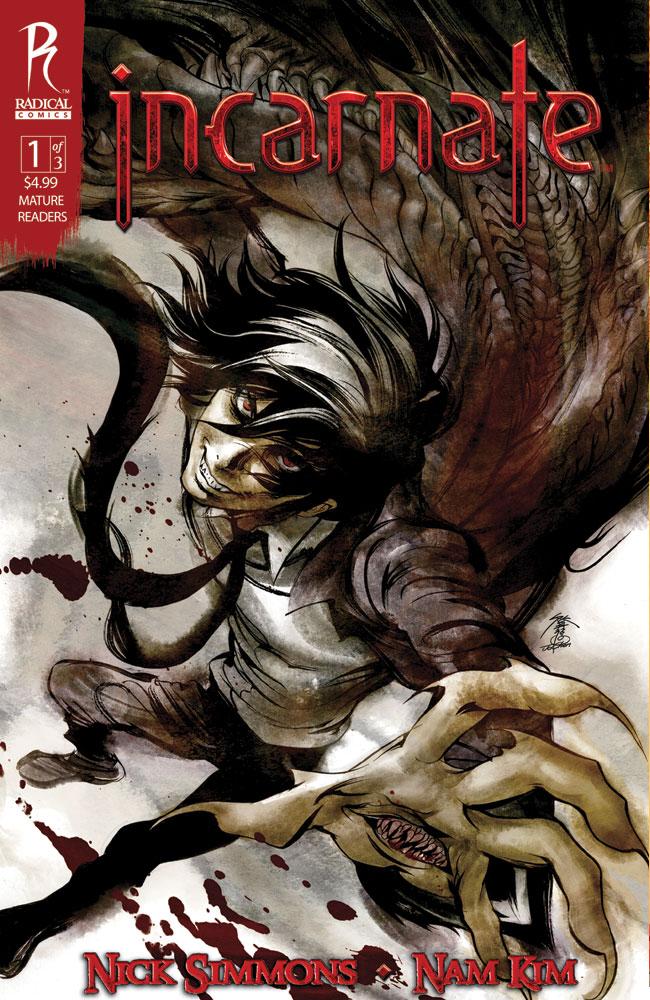
INCARNATE #1
Writer: Nick Simmons Art: Nick Simmons Publisher: Radical Comics Reviewer: Matt Adler
INCARNATE is the latest offering from Radical Comics. It’s somewhat of a departure from their usual fare, in that Radical typically leans towards ultra-realistic art styles that can easily be translated into movie storyboards, since a major part of their business seems to be using comics to develop pitches for Hollywood. Here, however, comics newcomer Nick Simmons, son of KISS rocker Gene Simmons, provides both writing and art, and his art style is squarely in the Amerimanga form.It’s not hard to figure out that Radical would not have published the same comic from Joe Smith; it’s the Simmons name they’re looking to cash in on and use in pitch meetings (I’m sure it doesn’t hurt that Radical publisher Barry Levine was one of KISS’s main photographers). I’m always somewhat wary when comics have this sort of pedigree; I come from that outdated school of thought that believes comics should be sold on the basis of ideas and talent rather than name recognition. But that doesn’t mean a comic coming from the latter origin CAN’T be good. So what about INCARNATE?
Well, it’s pretty good. I’ve seen plenty of bad Amerimanga, but Simmons gets the style down pat, and he has some very interesting, distinctive character designs. It’s cartoony in the way that manga often is, with exaggerated expressions and such, but not so that it disrupts the atmosphere. His style also presents a dynamic sense of motion from panel to panel, and lends itself to some entertainingly graphic scenes of gore.
As for the writing, it too is fairly solid. There’s a nice blend of humor and violence, and the dialogue between the characters usually reads authentic. There is the occasional awkward turn of phrase (“sopping scarlet treats”) but that’s par for the course for a new writer finding his footing. The plot, as a set-up piece for a larger story works perfectly well, though it doesn’t really offer anything new or insightful; thus far, it’s a fairly standard humans vs. the immortal undead bit. But the appeal of this book lies more in the characterizations and the visual aspects than the intricacies of the plot.
Ultimately, it will be interesting to see whether this book heralds a new phase of expansion for Radical, in broadening their artistic range. The manga style, when executed as well as it is here, has the potential to reach a brand new audience. Personally, I think Simmons might be a better fit for other companies; with a little time to hone his craft, he could eventually be writing and drawing for Marvel or DC.
In most places, Matt Adler goes by the name his mother gave him, but occasionally uses the handle "CylverSaber", based on a character he created for the old DARK FORCES II: JEDI KNIGHT game (one hint of his overweening nerddom). He currently does IT and networking support for the government of Nassau County, NY, but his dream is to write for a living, and is in the process of figuring out how to get publishers to give his stuff a look. In the meantime, he passes the time by writing for AICN, CBR, and a few other places. He has also written for MARVEL SPOTLIGHT magazine.
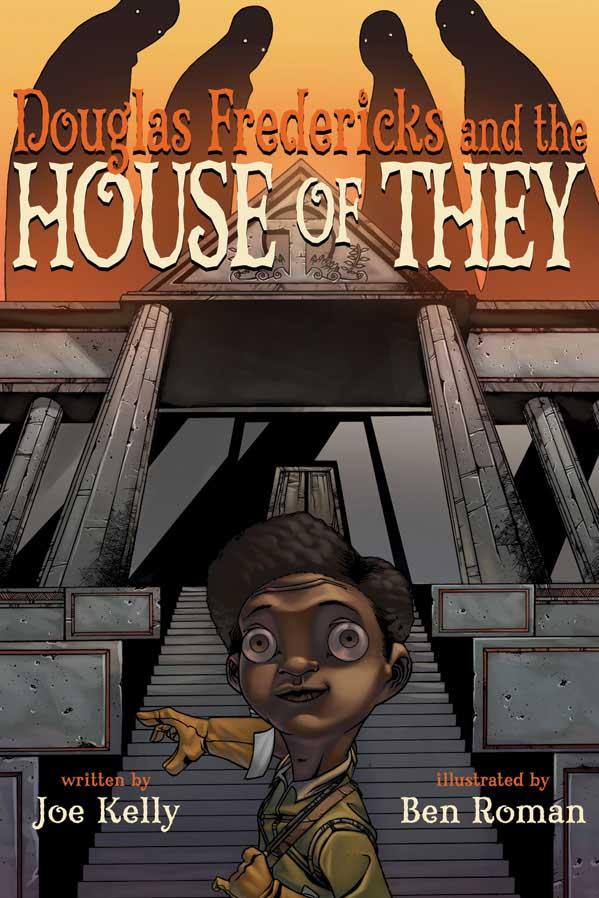
DOUGLAS FREDERICKS AND THE HOUSE OF THEY OGN
Writer: Joe Kelly Artists: Ben Roman Publisher: Image Comics Reviewer: Optimous Douche
Comic guys have amazing senses of humor on and off the page. The sheer delight I see in some of their eyes as they hand one of the filthiest minds and mouths on AICN children’s bedtime fodder always makes me wonder whether they are challenging me or simply have no idea who Optimous Douche is when they present materials.Take Joe Kelly for instance, the creator of BEN 10 and I KILL GIANTS. When I met Joe at Wizard World last month and introduced myself with my official reporter credentials of “Wassup, I’m Optimous Douche from Ain’t It Cool News, what do you do?’ he picked up DOUGLAS FREDERICKS AND THE HOUSE OF THEY. No, Joe isn’t a mute; I was merely going for dramatic effect. As he picked up the book, we talked a little bit about BEN 10 and I KILL GIANTS, to which I honestly admitted I had not read either. We talked a little bit about Ain’t It Cool and whether Liam “The Kid” was really a kid, or merely a middle-aged man suffocated by Peter Pan syndrome (as opposed to the rest of us that simply embrace our collective Peter Pan syndromes). Finally he said, “If I can get you to grab one thing off this table it would be DOUGLAS FREDRICKS.” Yes, he had read my past reviews and while admitting very few kids traverse Ain’t It Cool News, a hell of a lot of Dads make it to this corner of the Web.
Make no mistake, DOUGLAS FREDERICKS AND THE HOUSE OF THEY is definitely a children’s book, but it is a book specifically crafted to deliver this picture storytelling medium we have all grown to love to the next generation. I said it before with the last children’s oriented material I reviewed; if we want to keep the medium alive we must think about the children (Sally Struthers mode off).
If I had to boil down the over-arching theme of DOUGLAS into a dirty limerick it would sound like “Do what you can and fuck the man.” Even in the opening inscription, Kelly challenges his children to always ask why.
Douglas is an enterprising young lad, constantly bucking convention and attempting the seemingly impossible. In the opening pages he is carefully finishing the world’s first aerobatic camel--that is, until a town elder says, “you can’t do that.” Perhaps the smelly desert beast of burden could fly, but alas THEY say it can’t be done, so why even try? Likewise, when Douglas tries to teach a very very very old dog new tricks, a member of his own generation invokes the voice of the ethereal THEY with the adage. “They say you can’t teach an old dog new tricks.” Finally, as Douglas tries to deliver the world’s most spectacular gift for his parent’s impending wedding anniversary, once again the voice of THEY says it can’t be done.
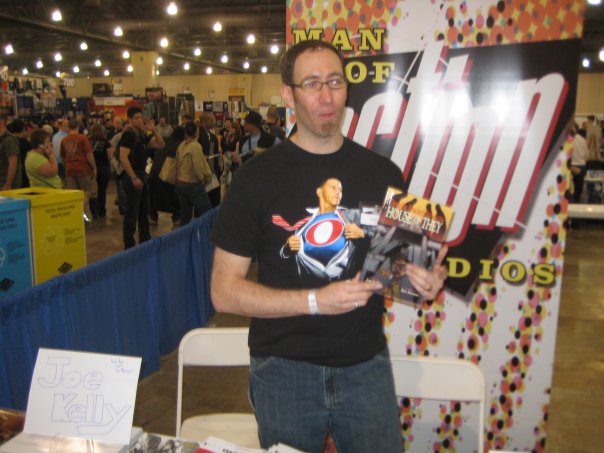 Now, were I writing this book, Douglas would have said something like “Fuck this noise, it’s time to bitch slap some THEY.” or “I think Things Remembered is having a sale on engraved picture frames this weekend.” Thank God Joe has infinitely more understanding about the minds of children and infinitely more understanding about effective story narrative. Douglas discovers that THEY have always been present if you just know where to look.
Now, were I writing this book, Douglas would have said something like “Fuck this noise, it’s time to bitch slap some THEY.” or “I think Things Remembered is having a sale on engraved picture frames this weekend.” Thank God Joe has infinitely more understanding about the minds of children and infinitely more understanding about effective story narrative. Douglas discovers that THEY have always been present if you just know where to look.Atop an ominous hill, inside an ominous fortress, THEY reside. Naturally THEY are protected by a gate keeper who forces Douglas to go through an inordinate amount of ridiculous shenanigans to gain entry. As Douglas was off performing his various tasks, I immediately made analogies to the impossibilities of penetrating our own government and just how inaccessible it feels to the average citizen. Well, I guess I must have been channeling Joe’s headbox because when we finally get to see THEY, they are indeed the pillars of society in cartoon form. Despite their cartoonish nature, Roman’s renditions of our are immediately recognizable: business, military, police and church all stand at the ready to crush Douglas’ flights of fancy simply because they say so, that is until Douglas exclaims…Why? Without an answer, all becomes right with the world.
Every moment of DOUGLAS FREDERICKS is charming. The use of the terms headbox and heartbox to explain the inner inspiration of a kid that loves gadgets was…charming, likewise with all the rest of Joe Kelly’s narrative. Roman’s saucer eyed children, withered old folks and intricate scenes were also… charming. There were even moments when I even felt all warm and mushy inside based off the font-choice; think basically Times New Roman with a fairy tale flourish. As with all things comics these days, the price of entry might be steep, but for a well-crafted children’s book that seems to speak to a unique type of inquisitive child (like Douglas) this is the best, if not only game in town. Also, as we adults struggle with the over arching feeling that we have become mere cogs in the great bureaucratic machine of life, Douglas’ lesson is one we can all benefit from.
When Optimous Douche isn’t reading comics and misspelling the names of 80’s icons, he “transforms” into a corporate communications guru. "What if the whole world had superpowers? Find out in the pages of Optimous’ original book AVERAGE JOE. Read the first full issue on Optimous’ New Blog and see original sketches by fellow @$$hole Bottleimp. If you are a publisher or can help these guys get AVERAGE JOE up, up, and on the shelves in any way, drop Optimous a line."
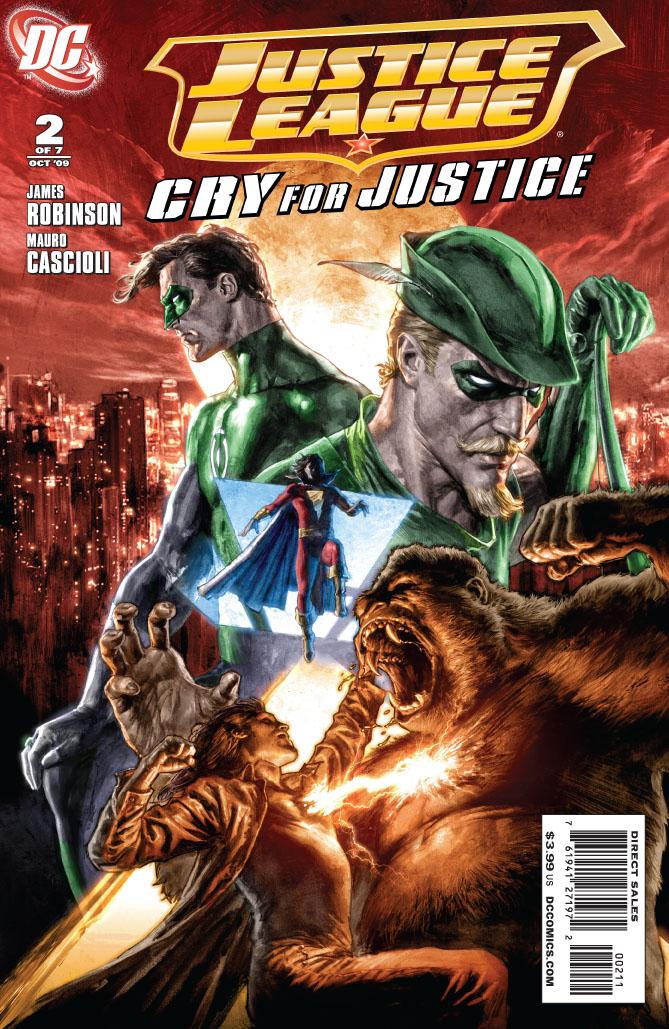
JUSTICE LEAGUE: CRY FOR JUSTICE #2 (of 7)
Writer: James Robinson Artist: Mauro Cascioli Published by: DC Comics Reviewed by: BottleImp
Judging from the talkback response and the correspondence between the @$$holes, I seem to be the only comic book reader who liked the first issue of this series. I had felt that this new Justice League series, though still a far cry from the best of Robinson’s work, was a marked improvement over his current run on SUPERMAN. Granted, the scene with the two Atoms was a little messy and the two sets of narrative captions felt contrived, but on the whole I thought that the comic worked. I respected Robinson for forming this latest incarnation of the League more organically than the last time, when Superman, Batman and Wonder Woman were sitting around the table and basically playing what amounted to a superhero fantasy baseball draft. And I loved the fact that the League was once again going to be an eclectic mix of DC’s fringe and the icons of their universe—there’s just so much more storytelling freedom with B-Listers like Congorilla or Mikaal Tomas than with Superman or Batman. So yes, I was looking forward to more of this series.One scant issue later and I’m firmly planted on the other side of the fence with my fellow @$$holes.
I don’t know what happened to James Robinson that made him forget how people actually talk, but boy, it sure did a number on him. Every single character in this issue speaks with the same voice, whether it’s the liberal tree-hugging Green Arrow, the conservative and fearless Green Lantern, the physicist/superhero Ray Palmer, or the big game hunter trapped in the body of a golden gorilla. Every single person speaks with that fragmented sentence, stream of consciousness dialogue that Robinson loves so much. Every character describes their likes and dislikes in a hip, ironic manner. Despite their obvious differences in appearance, ability or personal history, every single one of Robinson’s new League reads as the same character. It's like the SUPERFRIENDS cartoon, only instead of everyone sounding bland and whitebread, the heroes all sound like hipster douchebags.
Leaving the dialogue aside, Robinson’s seemingly straightforward plot of the heroes seeking justice for the murders of their friends begins to tangle and grow perforated with holes. In issue #1, the Greens began their quest for justice SPECIFICALLY with the aim of bringing in Libra and the Secret Society, who were directly responsible for the death of the Martian Manhunter and indirectly responsible for Batman (if he really did die…). However, the second issue begins with them in Gotham City tracking down villains working for Prometheus. What happened to the original plan? And then there’s the ludicrous obligatory fight scene…between heroes Congorilla and Mikaal Tomas, the blue-skinned Starman (the obligatory heroes/villains fight scene was relegated to off-page, the better to fit in more awkward, stilted dialogue). How ludicrous, you ask? Well, in the span of one page they go from screaming, “KILL YOU!” “YOU FIRST!” at each other, to comparing their preferred methods of drinking iced tea. I’m not making this up. I’m actually surprised that Robinson didn’t take the opportunity to have one of the characters comment snidely about how often superheroes end up fighting each other over a simple misunderstanding, or something as equally ironic and post-modern. He certainly didn’t miss the chance to do so when Ray Palmer commented on his brief post-ZERO HOUR stint as a member of the Teen Titans: “That bit of [my past] feels like a dream. Like it almost didn’t happen at all.” Yeah, we get it already, the Atom’s had a long and sometimes ridiculous comic book history—now can we stop with all referential noodling and get on with the plot already?
Robinson’s style of writing worked in STARMAN, but mainly because that series was set in its own little corner of the DC Universe with its own little characters—indeed, some of the worst moments from that series were when “mainstreamers” such as Batman or the Justice League popped in for a visit. The two worlds were never quite able to coexist comfortably… just as the world of this current Justice League is not meshing with the style that Robinson either refuses or is unable to change.
Unfortunately, the writing is dragging CRY FOR JUSTICE down into the depths of comic book mediocrity despite the exquisite artwork of Mauro Cascioli. It’s too bad that such fine visual work is being wasted on such substandard words. Hopefully Cascioli’s next project will be written on the same high level as his artistic ability.
And for the icing on the cake, once again I was incensed by DC spreading out twelve paragraphs of Robinson’s rambling ode to the Atom to fill seven pages of “content” and therefore “justify” the dollar they added to the price of this comic. Screw you, DC—I’m taking my money elsewhere. ‘Cause this series just isn’t even worth last year’s cover price.
When released from his Bottle, the Imp takes the form of Stephen Andrade, an artist/illustrator/pirate monkey painter from the Northeast. You can see some of his artwork athere. He’s given up comics more times than he can remember. But every time he thinks he's out, they pull him back in.
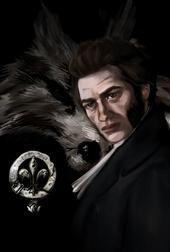
EX OCCULTUS: BADGE OF LANGAVAT One-Shot
Writer: Robert James Russell Art: Sandra Lanz Publisher: Saint James Reviewer: Mr. Pasty
Scripting a character in a mainstream comic book must be a difficult task. I can only imagine the pre-production meeting for some of the major Marvel titles that recently reached issue #600. (“Okay people, what haven’t we covered since Hulk’s debut in 1962?”) To that end, independent books can often cleanse the palate in between the life-and-death retreads over at the big two and Saint James’ latest effort is no exception.I went into EX OCCULTUS with a sort of giddiness that is usually reserved for teen girls with a gift certificate to Claire’s Boutique. This is primarily because its “Le Pacte Des Loups”-ish story is set in the mid 1800’s, which has long been an era of great interest to me (damn you Laura Ingalls Wilder!)
BADGE OF LANGAVAT (BOL) follows two chaps through a Scottish land of lost treasure and dark magic. One of the book’s strengths is Russell’s restraint in the use of supernatural elements, despite the narrative’s dependence on it. While sorcery is integral to the story, his ability to keep it from overshadowing his character development makes for an immersing and engaging experience rather than a flaccid assembly line of clichéd plot devices.
I also appreciate the fact that Russell isn’t afraid to take risks. The never-entertaining theme of child abduction is explored but the narrative traps it within the context of that time period. Nineteenth century folklore was rampant with the kidnapping of children and often painted fairies as the main culprits. In a nice twist on an age-old fear, the fairies here actually work to resolve the problem rather than act as the catalyst for it. BOL also doesn’t waste any time getting its hands dirty. I like that. Nothing kills a book faster than a couple of pages of exposition that does more to spoil the story than it does to help prepare you for it.
At first glance the artwork may seem a little underwhelming, but Sandra Lanz is steadfast in her commitment to the era -- and it pays off. Landscapes are distant and indistinguishable. Rooms are empty and void of flair. This is exactly what I would expect from a depressed village in 1864 and Lanz compliments the tone with an unassuming style. How many times have we seen an artist use their pencil to animate their resume at the expense of the story? Not every panel has to look like a stained glass window at St. Thomas Cathedral and Lanz subtly draws you into the moment rather than distract you from it.
I’ve seen so many independent titles fail because they unsuccessfully try to mimic mainstream books. Others tend to overcompensate by going too far in the opposite direction. EX OCCULTUS: BADGE OF LANGAVAT manages to find just the right note. It won’t bore you with a “me-too” regurgitation of the same crap we’re forced to ingest from the major rags, but it also won’t turn your stomach by inundating you with severed body parts and fervent fornication. It may not have all the bells and whistles you would expect from a major publisher, but when you can tell a story as well as the crew at Saint James can, you’ll find yourself wondering why you ever needed them in the first place.
Final word: Not since “Altered Beast” have the adventures of brawling werewolves been this much fun. Check it out.
Web heads who can’t get enough of Mr. Pasty’s word vomit are encouraged to watch him operate as Nostradumbass over at here. MMAmania.com. Love, hate and Mafia Wars requests should be directed here.

BACK TO BROOKLYN TPB
Story by: Garth Ennis & Jimmy Palmiotti Art by: Mihailo Yukelic Published by: Image Comics Reviewed by: Baytor
There’s one thing wrong with this book. Its dull lifeless art and its…Wait…wait…there’s two things wrong with this book. Its dull lifeless art and its dull uninteresting coloring and its…
Three…three…there are three things wrong with this book. Its dull lifeless art, its dull uninteresting coloring and its dull un-involving plot, and its…
Fuck it, there’s a hell of a lot wrong with this book. I knew the second I flipped the book over and saw quote after quote raving about how good the book was…and only one of them was from a comic reviewer. Not to put my role as a comic reviewer into any sort of importance, because I truly believe there’s nothing so worthless as a comic reviewer (save for a music reviewer), because most of our audience is reading our reviews to see what we thought about comics they’re already reading, often so they can disagree with our opinions. Nine times out of ten, we’re on a feedback loop and I wouldn’t give a dime for a comic review written by anyone.
But when someone casts the net out to their friends and colleagues and you wind up with Frank Tieri on the back cover of your book saying what a great fucking book you’re holding in your hands…it just feels like they’re trying way too hard, although the weird part is that I spent a few minutes looking for good reviews on-line and found a fair number of them. Mind you, none of them were filled with glowing, over-the-top praise and they weren’t terribly quote-worthy, but that’s pretty much what you get.
Look, it’s Garth Ennis. If you’ve been hanging around the comic industry for the last 15 years, you know the name and you’ve probably crossed his path more than a few times. You might love him or hate him, but you’ve got a fair idea of what you’re getting when you crack one of his books. In this case, it’s a “realistic” crime story and if you’ve read PRIDE AND JOY, you’ve got a rough idea of what he’s bringing to the table. It’s violent and there’s going to be a bit of humor, but he’s playing it straight.
But even looking past the lifeless art and way-too-muted color scheme, his story is pretty fucking unremarkable. The violent bits are good, especially the fight at Coney Island, but the story is hamstrung by its very premise. The story starts with the second-in-command of Brooklyn’s most feared crime family offering to expose every last bit of nastiness that his family has been up to. So, right off the bat, it feels wrong. The second-in-command of a feared crime family is portrayed as a decent, likeable, stand-up guy?
 Really? That’s the hook?
Really? That’s the hook?And as the story progresses, we find out why he decided to betray everyone he knows, which, quite frankly, isn’t the world’s biggest shocker. It’s the sort of thing that could easily lead to him killing his brother, the number one guy in the organization; but turning state’s evidence seems really out of character for someone who would had to have been brought up despising cops on a primal level. Simply removing the police angle would have improved the story immeasurably. I’ve seen THE SOPRANOS and GOODFELLAS, so I’m cool with a goombah operating as an honorable bastard, but not him selling out to the cops unless he’s trying to avoid a prison sentence.
The reason he went to the cops is to protect his wife and son, but this is told, rather than shown, which is a big mistake. The fear we are supposed to feel for them never quite manifests itself as the plot focuses more on the McGuffin that is the video tape that set everything in motion. As it turns out, there’s a reason why we’re not shown the danger they’re in, but it’s too clever (in a dumb sort of way) to feel genuine.
This isn’t an awful book. It’s just so desperately mediocre. One of Ennis’ regular artists might have salvaged it, because his stories are very dependent on facial expressions; but Vukelic’s artwork, while technically pretty good, is lifeless to the extreme. And it’s got that awful, washed out coloring that far too many publishers foist upon us; so absolutely nothing pops out at us. To see the book that should have been, take a look at the thumbnail of Phil Noto’s alternative cover to the first issue featuring the red-head with the “Defend Brooklyn” t-shirt. Unfortunately, the book in question is nothing like that.
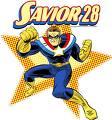
THE LIFE AND TIMES OF SAVIOR 28 #5
Writer: J.M. DeMatteis Art: Mike Cavallaro Publisher: IDW Publishing Reviewer: Matt Adler
I usually don’t review two issues in a row of a series, but in this case, it was worth it. This final issue comprehensively ties up many of the themes raised in the series. That’s not to say it resolves them, since many of these issues will probably go unresolved till the end of humankind, but it does provide a nice thematic conclusion to the series.One of the major themes of this series is how the American public treats its heroes. Throughout the series, DeMatteis has tied his superhero story into real life parallels, and here he uses Orson Welles for purposes of comparison to Savior’s fall from public grace, which works pretty well when you consider that the director of CITIZEN KANE was reduced to doing commercials for frozen vegetables towards the end of his career. There’s a nice in-joke here when Savior tries to stay relevant during the ‘60s; it reads, at least to me, like a subtle poke at the superhero comics of that decade and the next, where writers often tried to give their superheroes “hip lingo” and socially relevant stories…but still had to work in the requisite punching and kicking.
That’s one example of how DeMatteis manages to fairly seamlessly weave elements of humor into what is an otherwise pretty serious story (featuring a once-beloved hero humiliated, tortured, and shot through the head). He also pulls the humor off well in a scene where Savior and his former foes-turned-allies address the UN, appealing for peace. The way this story is supposed to play out in superhero comics is that the hero stands in front of the world leaders, makes his impassioned pitch, and they all jump to their feet in a standing ovation, and the world is changed in a single moment. DeMatteis addresses this expectation head-on…and then basically says, “Are you kidding me?”
Credit also must go to artist Mike Cavallaro for this scene; there’s a fantastic wordless panel where Savior stands in the center, obliviously waiting for events to play out as described above, and to either side of him are these former supervillains giving him a look that says “Um…you sure about this?” How you can give an inhuman sea monster a look of uncertainty and nervousness, I’ll never know, but Cavallaro pulls it off.
A good writer requires you to think and question, but not to necessarily agree with his conclusions, and that’s the case here. I most definitely do agree with the overall conclusion of this book that war and violence are not the ultimate answer to the world’s problems, but I have some quibbles with some of the more specific points made. During his UN speech, Savior makes reference to World War II, saying:
“Sixty years ago my country had two enemies we vowed to destroy: Germany and Japan. Now, this isn’t history to me—I was THERE. We HATED them…they hated us—with a passion that nearly CONSUMED the planet. Each nation reduced the other to a stereotype in order to justify its savagery. Let’s face it, if your opponents are sub-human…then it’s all right, isn’t it, to put them in concentration camps…or drop atomic bombs on them?”
Here are my problems with this. First, I think any moral evaluation of a conflict has to determine whether there is an aggressor and a defender, or simply two mutual aggressors. The US tried pretty strenuously to stay out of WWII (some would say too strenuously, given the events in Europe). That is not to say that having the role of defender against an aggressor excuses all actions on the defender’s part, but it does make a difference in the moral equation, I think.
As for hating Germany and Japan and vowing to destroy them: to be sure, once the war started, jingoism was whipped up to fuel the war effort, and racism was a pretty integral part of that (see the internment camps). But I think it is also important to note that this was an EFFECT, not a cause, of the war. The atomic bombs dropped on Hiroshima and Nagasaki will always be the most controversial action on the Allies’ part; the debate will continue to rage; did we save more lives than we took by ending the war there and then? But there are no two ways about it: innocent men, women, and children were killed by the thousands in those blasts, and thousands more suffered the aftereffects for generations.
And yet as extreme and terrible as nuclear weapons are, they are simply an extension of what all war does: kill innocents, and leave those left behind with shattered bodies and minds. So the question in this case becomes, should we have fought in World War II? My answer is an unequivocal yes. I do not believe that, in this case, a greater moral good could have been achieved through non-violent means. I think that under certain extreme cases, when faced with a ruthless and determined aggressor, there is no moral way to avoid war. So I’m not sure Savior’s example works for the overall point he’s trying to make.
Another point DeMatteis makes-- and it’s one I’ll have to ponder, since I’m not sure where I stand on it—is that heroes are seen more as leaders, rather than celebrities. He uses the public revelation of Savior’s mental breakdown to make that point that while people may be able to understand and empathize with loved ones who go through personal problems, or sympathize with celebrities going through very public personal struggles, they are not so tolerant of their leaders’ personal problems, saying “…if they so much as admit they’ve been to a therapist—we toss them right out the door” (perhaps alluding to George McGovern’s 1972 running mate). Are our heroes our leaders (or for that matter, vice versa)? I’m not sure.
Maybe it’s been so long since we’ve had a genuine national hero in American life that it’s impossible to say. But I think it’s equally possible they’d be treated more akin to a celebrity than a political leader. Ultimately, I think the reasoning behind the intolerance of personal flaws in our leaders (and this is still hypocrisy, but even hypocrisy has a reason behind it) is that we feel we’re putting our lives in their hands: we’re giving them power over us, so any hint of instability causes those prejudices to rise to the fore. This would certainly apply to Savior (given the great power he possesses) but I’m not sure it would work the same for heroes in real life.
The story ends on an ironic note; Savior has spent most of the series attempting to make grand gestures, and in the end, he inspires the world, with millions of individuals making a small gesture, which add up to one grand gesture. It’s not one that solves all the world’s problems, but it’s significant in its symbolism, which is after all, what a gesture is. There’s also a good deal of Christian imagery as befitting a superhero named Savior, and setting the scene on Easter Sunday dovetails nicely with the reveal at the end.
It’s funny; ordinarily with a series I enjoyed this much, I’d want to see a follow-up. But I think that would sort of miss the point here; there’s a finality to this story that’s appropriate, and a direct continuation probably wouldn’t work, although there’s certainly more to say about these themes and issues. Perhaps the real continuation has to be in our own world. To borrow words from this issue, maybe the best way to deal with these issues we face isn’t through violence or even with the power of celebrity; it’s for each of us to try to change the world “one heart at a time.”
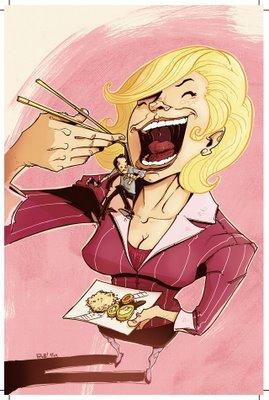
CHEW #3
Writer: John Layman Artist: Rob Guillory Publisher: Image Comics Reviewed by Humphrey Lee
Usually whenever a new title comes along that I give some attention to with its debut, I like to come back with a little follow up down the road, y'know, to give an idea of how it's progressed for those who might have missed it the first time, or for trade waiters and the like. Most times all that I figure is needed is a little Cheap Shot nudge as a reminder, but occasionally a book starts off so well that it deserves more than a paragraph. As you could imagine by the fact that the first couple issues of it have seen multiple printings now, CHEW is definitely one of those special little books.Again, for the uninitiated, Tony Chu is a Cibopath, which means he gets sensory feedback from whatever he eats. He's also now a member of the FDA, which has gathered a lot more power in the world of CHEW as chicken has become a banned substance due to the supposed Bird Flu outbreak. Given his unique talents, though, he becomes an especially valuable asset in the realm of homicide too because, yes, even humans count towards his gifts and it gives him a special insight as to what may have happened to the dearly departed. As you can imagine, this kind of talent makes Tony a bit of an outcast, as well as a bit twitchy because of the constant barrage of memories he gets even trying to enjoy a simple meal, except for beets it seems.
Now, when I first reviewed this book, I admitted I was already enamored with the quirky nature of the setting and its lead, and the humorous air that accompanies them, but that I was hoping there would be more to the world of the book itself, and that hopefully there would be characters that could accommodate these things appropriately. Two issues later, and I couldn't be more delighted to see that this hope has come to fruition. Already Tony himself has shown some great range as a character, as with the first issue he seemed a little too quiet for his own good, which is still the case at times, but after dealing with his new asshole boss at the FDA, and some Yakuza (Yes, Yakuza!) in the last issue we're now seeing even he has his boiling point, and a little bit of a bad-assed side. Getting up to this issue, we're back to that more introverted side of Chu as he spills a little bit of his soul to his partner from the first issue - still bandaged and in a coma from a scuffle back then - that he's fallen in love with a food critic with a unique ability of her own. It's all so fun and sickly sweet, even if it does, uh, involve a lot of vomiting. You'll have to see for yourselves, but it is kind of adorable in a way...
Mason Savoy, Tony's new partner, is also a great regular in the pages of this book. He's the perfect partner for this kind of book, as he's that guy that always seems to be the calm little center of the world, complete with the occasional witty jab on Tony's behalf, and is his gateway to his new job and his back up with dealing with his new boss, Mike Applebee, who as the "Previously In" page will tell you, is a complete asshole. The kind of asshole you kind of can't wait to see each issue and that you hope somehow gets a little comeuppance - the perfect foil to someone with a more withdrawn personality like Tony's. All of these elements and characters mesh so well with the humor of this book, which can be both understated or gross-out but also never comes off as lowbrow. And obviously there's some heart to the book now, even if it might be swallowed up by Tony's introversion, but that just puts more emphasis on it.
The success of this book is one of those special times in comics where something of great quality but not very significant exposure gets its due. Lord knows how many times we've seen some excellent material come down the pipe and then slowly die on the vine because it was hanging too far down from the mass market. Obviously, Image isn't exactly the most the preternatural of indie companies, but seeing as how maybe a handful of books from them at most make their way to the Top 100 a month, what CHEW is doing is remarkable, and it couldn't have happened to a better book. The characters are delightful, it's got all the little idiosyncrasies that make a work both entertaining and special, the art style is perfect to go with all of these elements, and it's simply a joy to read. Thousands have apparently savored what they've sampled of this book, what's stopping you from having a taste?
Humphrey Lee has been an avid comic book reader going on fifteen years now and a contributor to Ain't It Cool comics for quite a few as well. In fact, reading comics is about all he does in his free time and where all the money from his day job wages goes to - funding his comic book habit so he can talk about them to you, our loyal readers (lucky you). He's a bit of a social networking whore, so you can find him all over the Interwebs on sites like Twitter, The MySpaces, Facebookand a Blogger Account where he also mostly talks about comics with his free time because he hasn't the slightest semblance of a life. Sad but true, and he gladly encourages you to add, read, and comment as you will.
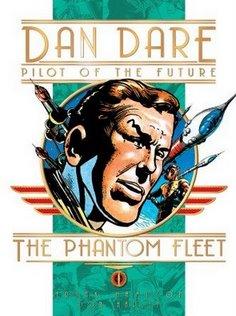
DAN DARE AND THE PHANTOM FLEET TPB
Creator: Frank Hampson Publisher: Titan Books Reviewer: steverodgers
Dan Dare, Pilot of the Future made his debut with UK’s Eagle comic in 1950. Frank Hampson’s creation thrilled UK youth and adults with his serialized adventures, managing to dollop out two pages a week every week until 1969. Dan’s adventures take place in the late 1990s, where as a colonel and space pilot in Interplanet Space Fleet he found himself saving Earth by using his smarts, a sense of honor, and good old-fashioned heroics.THE PHANTOM FLEET was my first exposure to the original Dan Dare; I read the Ennis series and have a passing memory of some of the 2000AD stories that my older brother had around. These reprints of the original run, lovingly compiled by Titan Books, certainly must be an orgiastic, nostalgic overload for some of our older English friends; however, there is a lot to offer for fans of contemporary comics as well, especially those with a science-fiction bent or who can appreciate masterful illustration, regardless of era or cultural reference.
As a new reader to Dare, the two-page format is a bit of a speed bump. There is a lot of story packed into those two pages, with a small recap panel to let you know what came before so you don’t waste your time reading the same panel twice from week to week. It takes getting used to, especially after a lifetime of 22-page American comics. It wasn’t until about half way in that I was able to dial into the story-telling technique of the day and not have it be work to follow along. Once you reach that point the story is rather marvelous: a group of tiny, on-the-run, water-based aliens (Cosmobes), who after being chased off their planet by evil fish aliens (Pescods) are looking for a new ocean to call home. The Pescods, in hot pursuit, decide to then colonize Earth and destroy humans as well with an unbeatable “red mist” weapon (Crimson Death) that melts anything metal. The dialogue is delightful with expressions and exclamations like, “Jumping jets!” and “Come on lads! Let’s smash that rotten thing!” The heroic men of the Space Fleet greet each new danger with confident surprise and a stoic heroism that is a credit to their British upbringing.
There is also a healthy dose of camp, especially in regard to Dan Dare’s best friend and rotund space companion, Digby, a Dumm Dumm-type character who loyally swishes through the action, fervently looking forward to his next nap and massive meal. Digby also has a young ward type, a freckled, red-headed lad named Flamer (that’s right, Flamer) who is forever stowing away on rockets and getting mixed up in Space Fleet business. The best of all, though, is Digby’s pet who has his own spacesuit: a striped, wildly expressive, insanely cute mini-elephant named Stripey, who tags along and exhibits his own brand of bravery, including a mad dash into the Crimson Death, his little feet padding along the desert floor, selflessly waddling into danger to save his master.
What stands out the most in THE PHANTOM FLEET, and what I think is the major draw, is the art. Frank Hampson puts on a master class in retro-rocketry future awesomeness. His gleaming, imaginative metal ships are decked out with dials, levers, and mechanical displays that are lovingly rendered and colored in light, colorful washes which are both realistic and whimsical. All the vehicles are spectacular, including the surface vehicles, with massive glass domes, and boats that dart across the ocean, hovering inches above the water on huge, not-quite-aerodynamic pontoons. The human faces are bright and shine behind space helmets, full of expression and emotion. The little alien Cosmobes are odd but believable, replete with gills, rainbow fins, and little jet packs attached to their tunics to fly about with. The evil Pescods exhibit a fishy, silent, creepy menace with diamond-shaped helmets and heavy blue armor. The action takes our heroes from space to the ocean to the desert with each vista and environment so confidently handled and believable that you get the feeling that there is nothing that Frank Hampson couldn’t draw.
There is something on every page to marvel at. It is imagination personified, and each panel explodes with cool touches of fancy and effortless charm. The story plods at times, but is mostly fun, and the art is absolutely stunning, making it a book you will want to return to again and again to find something new to admire with each visit.
DAN DARE AND THE PHANTOM FLEET brims with optimism and gallantry, and is a respite from complicated super heroes hung up on the grey areas of modern day heroics. In Dan Dare’s world, Earth is in peril and he simply has to get into his rocket ship. With his loyal friends at his side, he tips his cap and wiggles his lightning-shaped eyebrows at the lovely ladies of Space Fleet and charges into battle, once again off to save the world.
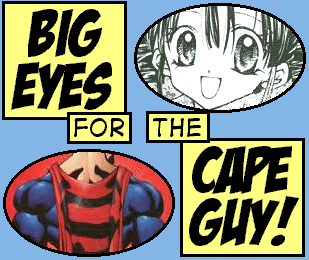
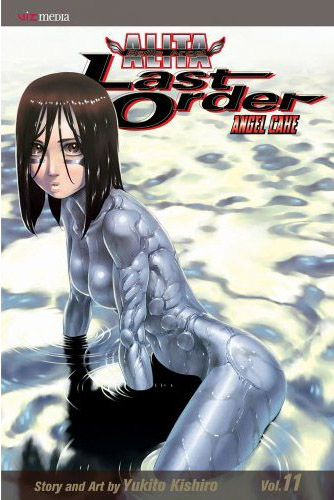
BATTLE ANGEL ALITA: LAST ORDER Volume 11 – ANGEL CAKE
By Yukito Kishiro Released by Viz Media Reviewer: Scott Green
Yukito Kishiro creates the ultimate fight manga adversary in ALITA: LAST ORDER. From the nanomachine-produced oceans of grey goo covering the surface of Mercury comes the Anomaly. "It eats! It mates! It butchers! A faithful translation of the principles of libido, the most despicable side of humanity on full display!" This daikaiju sized beast rages with its phallic cannon ejaculating energy blasts. "Pride! Greed! Combat ability! And all of us - powerless against this Freudian nightmare?!" Its opponent? Toji, the master of Electromagnetic Space Karate. "They say his karate goes beyond Newtonian mechanics and is on the level of the theory of relativity...I have no idea what that means..." So, a totem faced robot man in a karate gi is fighting PenisGodzilla. What more can you ask for in your gonzo fight manga?When James Cameron begins adapting his version of BATTLE ANGEL, presumably LAST ORDER will have little if any bearing on the project. This isn't the story of a cyborg brain given the body of a young woman and a second chance of life amidst the material and social discard of a sci-fi Utopia. It's the geek version of an interminable tall tale, spun out of an interplanetary fighting tournament. Kishiro has been riffing off reader submitted designs, some of which are cogent and detailed, some of which look scrawled out with MS Paint. And, he's been welding together ideas that shouldn't be in the same thought process (super-human thumb wrestling). It's not the effecting, character focused narrative of the original BATTLE ANGEL, but it is Kishiro demonstrating his black belt in the nerd arts.
This volume features almost no Alita, but it does have some Alita and Alita, and plenty of Alita. The Alita of the first manga series, and presumably the Cameron movie, is off the playing field at this point. Cute, molecular wire-wielding Alita clones Elf and Zwölf are side-lined, but present. On the other hand, transgender Alita clone Sechs makes his belligerent present felt - surfing Itano circus missile barrages, taking Alita's Damascus blade to foes like a can-opener, and otherwise serving as the primary agent for the protagonists.
Already volumes longer than the original BATTLE ANGEL ALITA, and with a fraction of its plot evolution, Kishiro is clearly in no hurry to pick up the pace of LAST ORDER’s story. Instead, he's leisurely sight seeing. LAST ORDER is structurally based on the shounen fight manga formula. Those manga habitually digress into histories of the personalities battling in the competition, and LAST ORDER is full of that. Previous volumes have delved into side stories, one of which filled two volumes. Volume 11 has at least one major plot point, but it's mostly taking advantage of the format to construct some exquisitely odd situations.
It's difficult to top the near confrontationally odd spectacle of Space Karate versus the Anomaly, but Yishiro continues to have fun with the conventions of fight manga throughout the rest of the volume. After the above mentioned karate/kaiju smackdown, Sechs fights The Jupiter Union Delegate - Warmen 609. This opponent is a geometric muscle man with a small, geometric, cyclops cat resting on his head, and the gag is that Jupiter has pooled all their resources to provide their champion with equipment that stops just short of the threshold of the limits placed by tournament rules. It would have been amusing if Kishiro worked in the metaphor of the fighter who cuts weight to outsize their opponent, but it’s just as fun to see rage-aholic Sechs battling the equivalent of an internet troll meets apparatchik. Lt Commander Chernov 727 rolls out in his battle sphere "at 500 metric tons and 50 meters in diameter, it's exactly under the regulation limit!" "Polymer capture: a high speed steam projection that instantaneously recrystalizes into a cube! A technology already in widespread use, this 'smart polymer’ can be recovered and recycled...so it isn't counted as 'ammo!'" "Since artificial intelligence guidance is banned, we have to use another approach! Metallic helium warheads should do the job! 'Ecological carpet-bombing' - that's our green friendly national policy!" Though LAST ORDER isn't much of a character work, it certainly does know how to pull strings to establish who to cheer for and against in its fights.
Scott Green has been writing for AICN ANIME for over eight years. If you like what you see here and love anime & manga, be sure to check out his latest AICN Anime every week here on AICN.

Welcome once again to Indie Jones. I’m Ambush Bug, damn glad to meetcha. This week, I continue to delve into my bag o’ swag that I got from this year’s San Diego Comic Con. Enjoy and seek out these delights from outside of the norm.
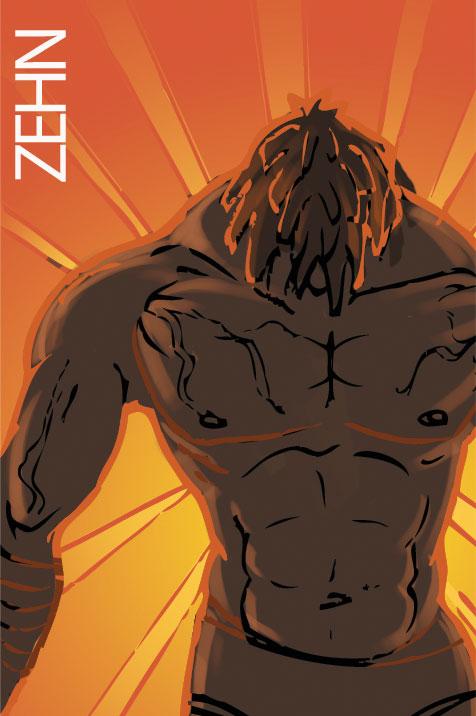
ZEHN Vol. 1 THE BEGINNING www.zehncomic.com
I had the pleasure of meeting ZEHN creator Michael Mwemba at this year's San Diego Comic Con and as he presented this book to me, I could tell it was a labor of love for him. This oversized comic takes place in a river town called Kariba in what looks to be Africa and centers around a trippy scenario involving bird-men, wizards, raven creatures, and a sorcerer fish in an unbreakable fishbowl. There' was a lot of imagination put into this comic and the powers and action are as elaborate as they are creative. I loved the scene where the evil raven creature tries to kill the sorcerer fish by simply turning the bowl upside down, but due to the fact that the fish controls water, he goes nowhere. There's a lot of creative use of magic in ZEHN and I look forward to future installments. This is about as indie as you can get, so don't expect a completely polished product. The creators should watch out for some grammatical errors and possibly keep an eye on centering the words in the middle of the word balloons, but all of these are just nits I'm picking. In the end, this little indie book packs a whole lot of fun action and creative ideas between its covers and I'm hoping Michael Mwemba and the artist, Zoro Rodriguez, get a chance to do more volumes so I can see their own talent and the cool story of ZEHN grow.
ROD & BARRY/ GENE'S JOURNAL Flipbook www.roddenberry.com
This free giveaway from SDCC was a lot of fun. As a person who received quite a few indie book requests and submissions for review, it's refreshing to check out a book that literally takes seconds to read. This simple flip book has some very cool cartoony art and a simple premise for both stories. First, Gene Roddenberry's lifetime achievement is explained when he is abducted by aliens while walking down the street one day. Turn the book over and we find our second story: two aliens plot to destroy the Earth but are placated by checking out stuff made by Gene Roddenberry. Simple and fun spins on the age-old flip book concept. David Reddick did a slick job of producing this tiny little book and it was a smart move to pass them out to folks at the con. Upon further inspection, it looks like this book is actually a cool advet for a much cooler website featuring the same characters. I clicked through quite a few of the fun serial and recommend you do the same if you have a few spare moments at the computer.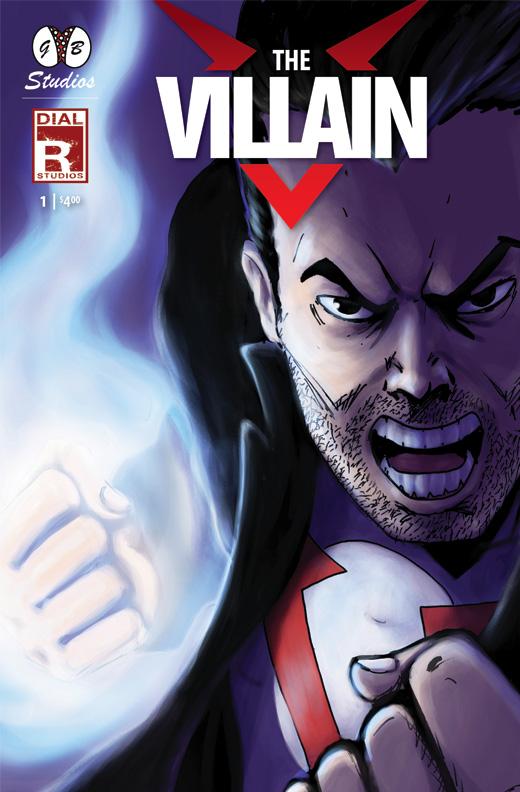
THE VILLAIN #1 Goodbum Studios & Dial R Studios
There’s a scene in THE VILLAIN that sums up the entire book. A nerdy kid gets pushed down in the middle of school. It’s your typical scenario where a bully picks on someone smaller and weaker than him. But the narrative doesn’t follow the nerd as does every other comic you can think of. The book follows the bully and continues to tell the tale of a boy who was always pretty bad and how this boy grew up to be a super villain. It’s a book asking, “What if super powers go to the wrong guy?” Steve Earnhart, the man behind the noir-tastic HARD-BULLIED COMICS book is responsible for this fun premise and he doesn’t waste any time diving into the action. This first issue is definitely worth checking out. Fun characters, cool powers, and nice indie art; THE VILLAIN takes super hero convention and flips it on its @$$.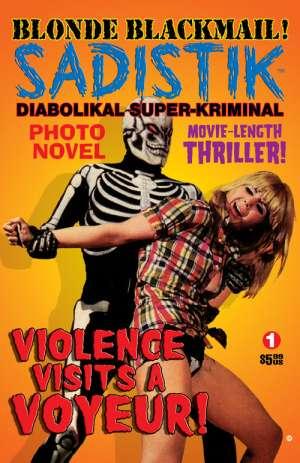
SADISTIK: VIOLENCE VISITS A VOYEUR #1 www.gosadistik.com
Anyone who enjoyed the old FAMOUS MONSTERS magazine would love this "photo novel" comic. I'm not sure if this was actually a movie or just an elaborate set of photographs, but basically, black and white photos are taken of actors and then word balloons are placed over the panels to tell a graphic story. The result is a real life comic that is every bit as dynamic and fun as reading a regularly drawn one. Sadistik is a vigilante who kills criminals and thwarts the police with advanced weaponry and sophisticated disguises. Reading this book was like watching SHOCK THEATRE with Dr. Creep back home in Ohio as a kid. This is an old school throwback to fifties schlock cinema, ripe with buxom beauties, fedora wearing baddies, and a very cool lead in a full body skeleton costume. The story is elaborate, yet motivated by one simple purpose; Sadistik is caught by a voyeur making love to his beautiful girlfriend without his mask on and now, Sadistik will stop at nothing to get those photos back. The storytelling is dynamic and the photos are vivid and tension filled. There's a whole lot of fun to be had with this comic. It's not your typical comic book experience and I'd love to see this "photo novel" approach done with other stories and characters, whether they be from old movies or original concepts. Click on the website above for more adventures of Sadistik.
